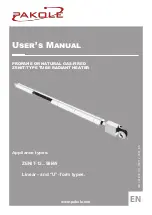
FUEL SUPPLY (CONTINUED)
• For proper propane tank sizing see page 21.
• Visually inspect the hose assembly and ensure that it is protected from traffic, building
materials, and contact with hot surfaces. If it is evident that there is excessive abrasion or wear,
or the hose is cut, replace it immediately.
• Purge air from line and wait 10 minutes for gas to dissipate.
• After installation, check the hose assembly for gas leaks by applying a water and soap solution
to each connection.
• Fuel hose must be UL approved.
• The installation of this heater to a natural gas supply must confirm with all applicable local
codes or, in the absence of local codes, with the
National Fuel Gas Code ANSI Z223.1/NFPA 54.
For vapor propane, refer to standard for
Storage and Handling of Liquified Petroleum Gases
ANSI/NFPA 58.
ELECTRICAL
• Electric cable extensions must be connected based on the unit capacity and cable length.
• We highly recommend a dedicated line, 15 amp minimum.
• Confirm voltage at heater connection (105V min.) to ensure proper operation.
EXHAUST FLUE PIPE
• The unit is to be connected to a flue pipe with adequate draft, to ensure the proper start and
operation of the unit. Refer to page 20.
• The flue pipe and its installation must comply with the regulations and instructions given by
the local authorities.
• A flue pipe must be used at all times. You must increase flue peipe diameter if its is
longer than 26”
DISCHARGE DUCTING (Warm Air)
• Minimum clearance from combustible materials is 4 inches.
• Use steel ducting or fabric ducting capable of withstanding maximum temperature of 225ºF.
• Maximum length of duct: 50’ (straight).
• Duct diameter: 12”.
• Make sure that the duct is safely and properly fastened to the outlet.
• Avoid sharp bends and corners to ensure maximum air flow and avoid back pressure/heat
accumulation in heater.
• Do not exceed 1/2” w.c. of back pressure.
• FAILURE TO COMPLY WITH THESE RECOMMENDATIONS COULD RESULT IN SHUTDOWN
OF THE HEATER.
5







































